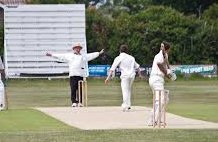
 |
| Back | ||||||
|
Wide that wasn't  In a local league match in the UK, the bowler bowled a short ball that pitched and went so high that it passed clean over the batsman's head. Even the athletic wicketkeeper couldn't leap high enough to stop it, and the ball bounced twice and went over the rope. Why did the umpire call and signal this as a No ball? Surely it was a Wide? The umpire then signalled a boundary four. But the scorers recorded five runs. Why?" Recreational matches are usually played under the Laws of Cricket and this type of high delivery used to be called a Wide. To discourage bowlers from such negative tactics, it's now a No ball. The one-run penalty for any Wide or No ball is now credited to the batting side, regardless of what else happens to that delivery. Five runs should be recorded - the one No ball penalty plus four Byes because the ball crossed the boundary without touching the striker's bat or person It should be noted that in International cricket the umpire does call a wide not a No ball These matches are played under the auspices of the International Cricket Council (ICC) playing regulations and situations such as this are seen on television and viewers become confused when they see the same scenario in recreational cricket with a different interpretation. Read more about Law 21 (No ball) and Law 23 (Byes and Leg byes) at the MCC web site | ||||||